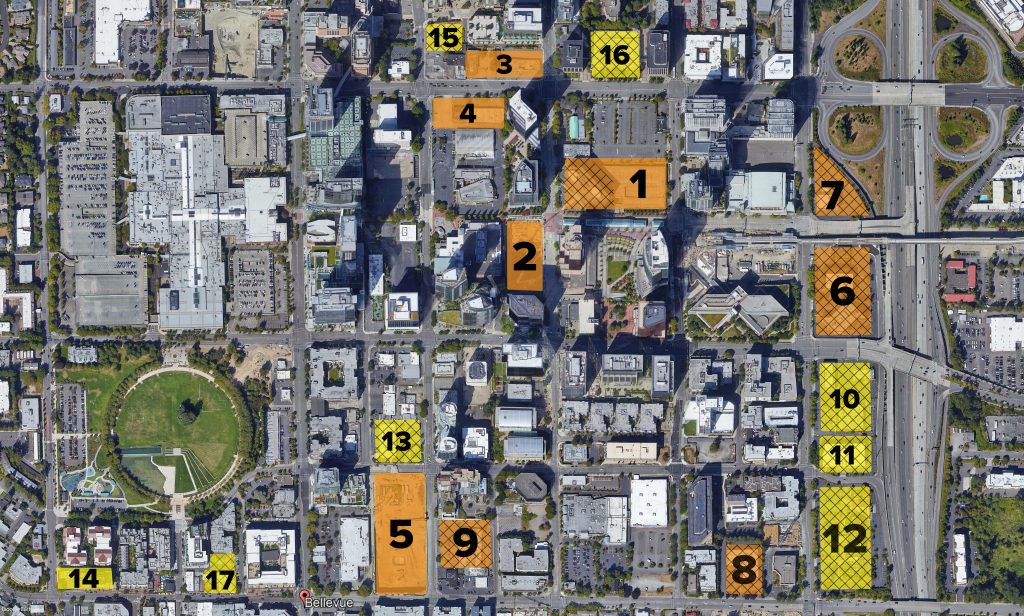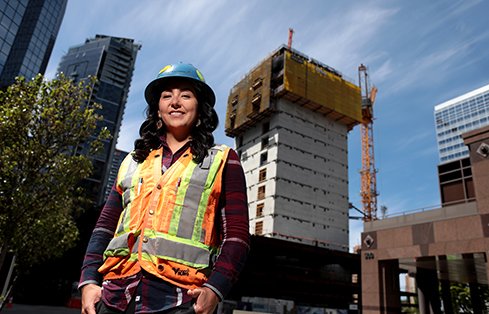The City of Bellevue, Washington, is becoming a showcase for GeoEngineers’ expertise in urban high-rise development. The firm’s advanced numerical modeling and performance-based approaches to geotechnical engineering are on display in more than 17 projects across downtown Bellevue, including five marquee projects under construction right now. Bellevue 600, 555 Tower, The Artise, The Eight, and West Main are all within a five-block radius in the Bellevue core, and they will soon have prominent places in the skyline. 555 Tower and Bellevue 600 will be the two tallest high-rise towers in Bellevue both reaching approximately 600 feet—150 feet more than the city’s tallest existing building.
Urban high-rises come with a unique set of geotechnical challenges. Tall buildings require high-capacity foundations and buildings taller than 240 feet generally require performance-based seismic design. The Puget Sound region faces seismic risks from the nearby Seattle fault zone and Cascadia subduction zone, requiring specialized design and careful analysis. Urban high-rise construction is typically lot-line to lot-line, so neighboring buildings and infrastructure are immediately adjacent to deep shored excavations. That means strict deformation control for the temporary excavation support systems that protect the adjacent buildings and infrastructure.
Working on large development projects in Seattle and Bellevue over the past 20 years has given GeoEngineers deep experience with local geology, groundwater and regulators. Senior Principal Geotechnical Engineer Matt Smith explains.
“We know the soil and groundwater conditions throughout the region,” says Matt. “We’ve seen all the typical design considerations that urban redevelopment projects are confronted with—and we have answers and experience to solve them in a cost-effective way.”
GeoEngineers has unmatched experience with high-rise seismic design, especially when a performance-based design (PBD) is required. In 2019, the City of Bellevue adopted a new set of seismic requirements for buildings over 240 feet tall. The decision was motivated by a University of Washington earthquake study that found that high-rise buildings in the Seattle basin will be affected by seismic forces two to five times greater than similar buildings outside the region.
“The presence of thick deposits of soil and soft rock in the basin, which can reach up to 7 km, strongly amplify long-period waves important to the performance of tall buildings,” says Senior Geotechnical Engineer Hamilton Puangnak. “Tall buildings resonate at a similar frequency, making the seismic forces acting on the structure that much stronger.”
For conventional low- to mid-rise buildings, designers typically use prescriptive seismic design procedures from the International Building Code (IBC). The use of prescriptive procedures implicitly assumes how a building will perform given prescriptive loads. On the other hand, performance-based seismic design aims to explicitly evaluate how a building is likely to perform given the potential hazard it is likely to experience. The latter requires a more careful evaluation of site-specific seismic hazard, which is not the objective of the national seismic hazard maps adopted by the building code.
For high-rise buildings, the City of Bellevue requires the more rigorous PBD approach to seismic engineering—one that Hamilton and GeoEngineers’ other seismic specialists have been using for many years.
“We’ve been doing performance-based seismic design for high-rise buildings in the Northwest since 2005, and at this point we’ve completed over 60 high-rise buildings with the PBD process,” Matt says.
The PBD approach allows geotechnical engineers to tailor seismic parameters to specific site conditions—and potentially reduce project costs along the way. Another aspect of PBD involves numerical modeling specialists like Geotechnical Engineer Yanbei Zhang, who assists with modeling complex excavation support systems using cutting-edge finite element/difference modeling. In tricky conditions, GeoEngineers relies on numerical modeling to develop practical solutions and accurate deformation estimates—and support project permitting.
“GeoEngineers has extensive experience with numerical modeling of complex excavation support systems and we’re confident in our modeling techniques and performance estimates,” Matt says. “Yanbei’s numerical modeling results in significant cost savings in excavation support systems and allows GeoEngineers to complete projects that other consultants may not be comfortable with.”
One example of GeoEngineers’ numerical modeling of excavation support systems is the concurrent construction of The Artise and The Eight, neighboring high-rises that both have ground anchors located in the NE 8th Street right-of-way. GeoEngineers used numerical modeling to find an efficient solution—a non-standard soil-nail excavation support system for The Artise project and truncated tiebacks for The Eight project. The team frequently validates creative shoring solutions like this with finite element modeling.
Many projects in Bellevue have below-grade levels that extend well below the groundwater table. Developers sometimes choose permanent dewatering solutions—provided that discharge volumes are below the limits established by the City of Bellevue. To reliably estimate the permanent dewatering discharge volumes, GeoEngineers’ hydrogeology team led by Associate Hydrogeologist Stephen Thomas is often called in to design and oversee full-scale pumping tests and hydrogeologic modeling.
GeoEngineers Development Projects in Downtown Bellevue

Map Key
In Design = Crosshatch
In Construction = No crosshatch
More than 240 Feet = Orange
Less than 240 Feet = Yellow
- Bellevue 600
Developer: Amazon Inc. - 555 Tower
Developer: Vulcan Inc. - The Eight
Developer: Skanska - The Artise
Developer: Schnitzer West - West Main
Developer: Vulcan Inc. - Terraline
Developer: Lane Partners
- 700 112th Ave NE
Developer: Portman Holdings - Wallace Properties
Developer: Wallace Properties - The Arcadian
Developer: Schnitzer West - Kanon
Developer: Beam Reach - 200 112th Ave NE
Developer: Columbia Pacific Advisors - Bellevue Vista Place
Developer: Tishman Speyer Properties
- Filament East and West
Developer: Vulcan Inc. - Eight One Hundred Bellevue
- The Nine
Developer: Skanska - Bellevue Plaza Apartments
Developer: KBS Realty Advisors - North of Main
Developer: Vander Hoek Corporation
